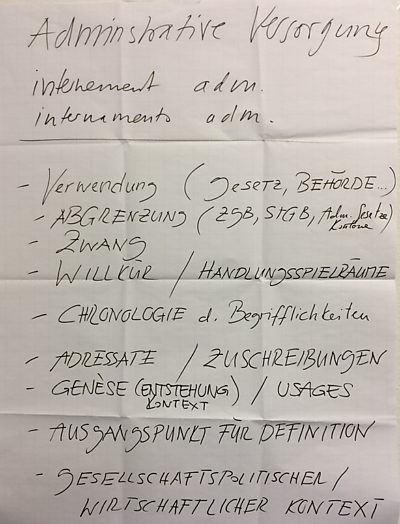Research Design

The IEC research programme seeks to reveal the underlying conceptions of state, statehood, law, society and the individual that informed the administrative measures used.
Excerpt from the IEC Research Design of 10 May 2016
|
In May 2016, the Independent Expert Commission (IEC) on Administrative Detention prepared a research design. The latter serves as a guideline for IEC researchers and is also available for consultation by interested readers.
The research design is based on the research programme adopted by the IEC on 26 May 2015. Opinions on the proposed programme were solicited from Swiss and international experts. Those expert opinions, together with responses by members of the Commission provided important input for the finalisation of the research design for the project as a whole and for the distribution of individual research assignments.
IEC Research Areas The research of the IEC is divided into five Research Areas:
Research Area A Research Area A deals with fundamental questions of relevance to all areas of the IEC’s work.
Research Area B: Statutory bases / Legitimisation and delegitimisation of administrative detention measures Research Area B is devoted to the historical and legal analysis of the laws that authorised, for purposes of social prophylaxis, the incarceration (sometimes for life) of certain categories of individuals who were classified on social or political grounds as problematic. On the one hand, an attempt will be made to describe and analyse the way those categories were defined and to examine the manner in which they were incorporated into legislative texts. This will include a detailed breakdown of the various areas of the law under which the mechanisms of exclusion were introduced (e.g., welfare laws, public drunkenness laws, guardianship laws, etc.). At the same time, a study will be made of the political and academic contexts in which such statutory instruments were drafted, maintained in force, and ultimately repealed. This will also include identification of the various actors (political leaders, legal practitioners, members of the clergy, journalists, administrative detainees, etc.) who participated in discussions of relevance to this study, the (legal, political, medical, social, moral and other) concepts that informed those discussions, the settings within which those discussions took place (political forums, psychiatric and medical contexts, religious or public settings, etc.), and the occasions that led to an intensification of those discussions. The goal is to provide an analysis of the power relationships that prevailed in those discussions and to place them in their historical context so as to better understand the processes that led to the legitimisation and delegitimisation of the use of administrative detention at different times and places.
Research Area C: Legal procedures and jurisprudence The focus of Research Area C is on examining the legal procedures for the use of administrative detention between 1935 and 1981 and their role in the development of the modern welfare state. Project C1 will provide a description and analysis of the various statutory bases that were invoked, taking reference to considerations of constitutional rights found in the case law of the Swiss Federal Supreme Court. Project C2 will examine the manner in which the applicable statutory provisions were applied in actual practice, including a review of the decision-making processes of the public authorities involved and the interpretation patterns on which their decisions were based. Of particular importance in this connection are the opinions of legal experts who were consulted at the time. Lastly, an attempt will be made to elucidate the logic behind the authorities’ actions and the power relationships that prevailed between those involved in the issuance of administrative detention orders and the individuals who were subject to those orders. Project C3 is devoted to an examination of the way the public authorities performed the duties of oversight incumbent upon them, in particular, in the context of appeals procedures.
Research Area D: Institutional practice The research conducted in Research Area D will conclude with a description of the main features of the institutional practices that characterised the use of administrative detention in Switzerland up to the year 1981. This includes a consideration of the economic factors involved, of detainee release procedures, and a contextualisation of those practices against the broader background of transnational organisational developments. All detention facilities have their own unique institutional history, subject to their own internal dynamics, and often detached from their immediate social surroundings. This gives rise to divergences between the conduct that is expected of the detention facilities and their conduct in actual practice. Beginning with five in-depth longitudinal case studies of major detention facilities («key institutions») in different regions of Switzerland, other possible routes that the path of detention could take are traced on the example of individual life histories. This is done with a view to presenting an overall picture of the federal structures underlying the practices of a wide-ranging network of institutions staffed largely by volunteers and lay personnel.
Research Area E: Biographies and life stories The reconstruction and analysis of the life stories and accounts of individuals who were subject to, or who helped shape, the life-changing procedures of administrative detention in closed facilities is the focus of the relatively self-contained sub-projects E1 and E2. Subproject E1 is preparing two publications: an annotated edition of the sources and a situational historical analysis of individual life stories as recorded in the case files, of the stages in the lives of former detainees, and of the major turning points in their lives. Another book, to be prepared by Project E2, will describe the dynamics that played a role in determining the course of the lives of former detainees following their release. This will be done by taking into account habit formation processes and opportunity structures that develop in childhood and adolescence, using a methodology based on the coding and hermeneutic-sequential analysis of non-standardised data. The reconstructed biographies will also be used in Research Area E as the basis for a volume of portraits of former administrative detainees, written in a reader-friendly style. Contributions to that volume will also be accepted from members of the research teams of other IEC Research Areas. |
|


